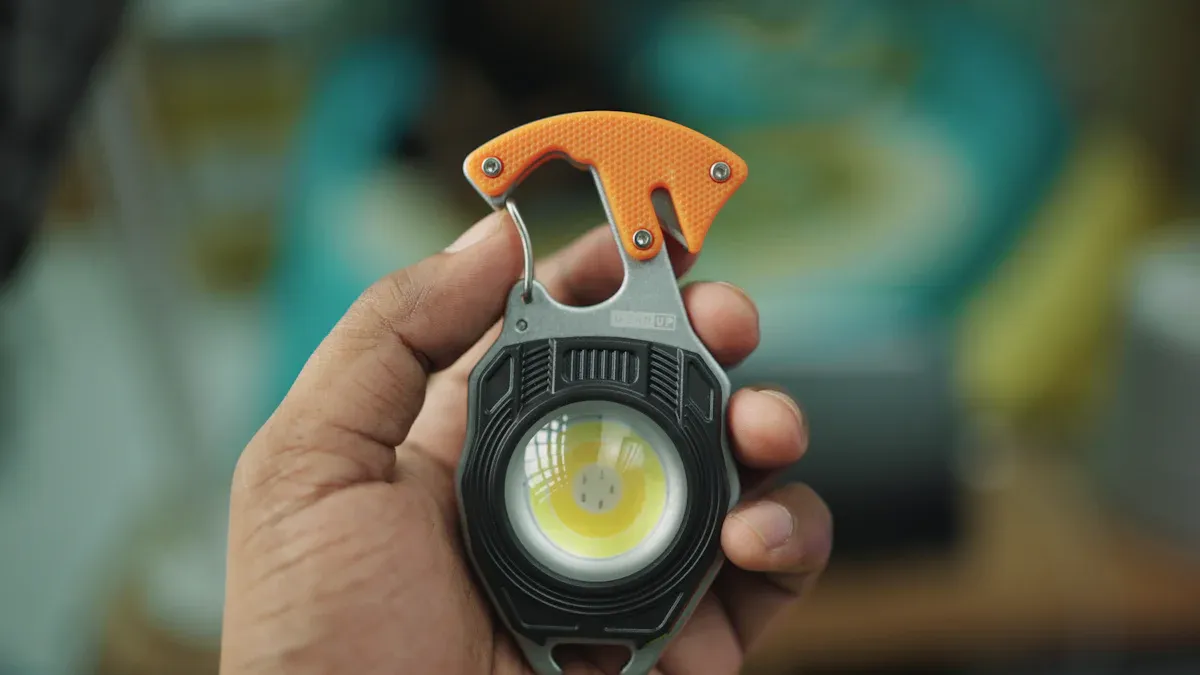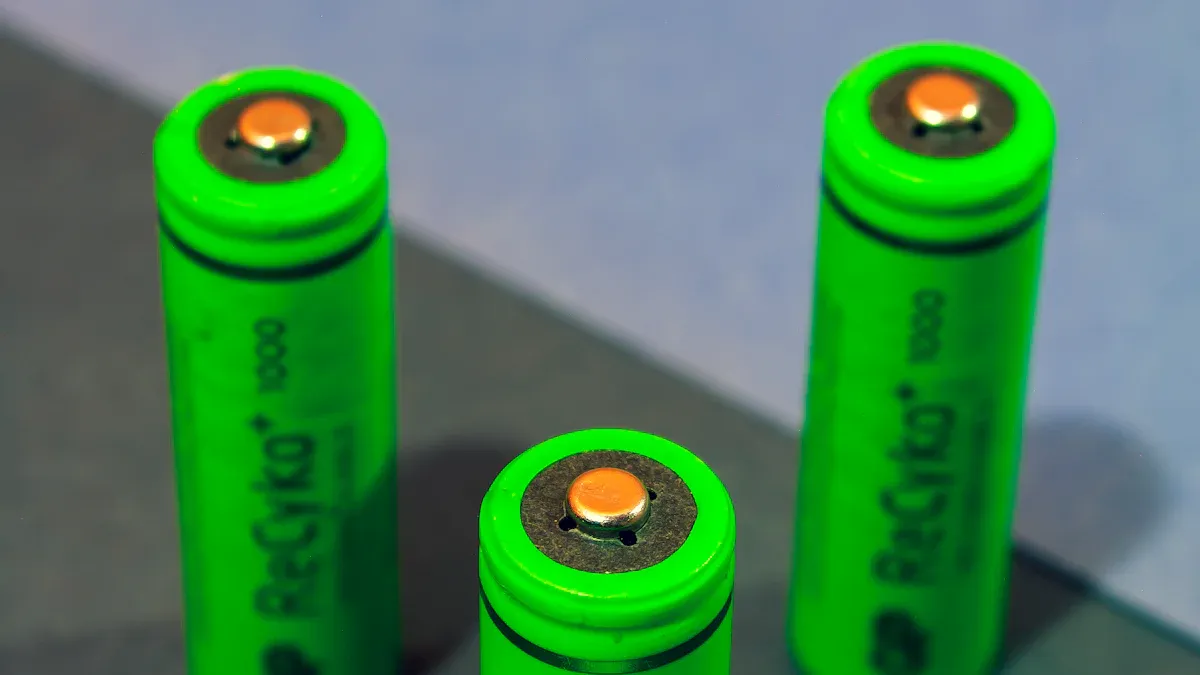
Hotels require reliable flashlights to ensure smooth operations and guest safety. Choosing between rechargeable and disposable battery flashlights significantly impacts costs, environmental sustainability, and efficiency. Flashlights also play a crucial role in hotel emergency lighting, ensuring preparedness during power outages or unforeseen events. The decision depends on the hotel’s specific needs, such as budget constraints, operational priorities, and long-term sustainability goals.
Key Takeaways
- Rechargeable flashlights save money because they don’t need new batteries often. This makes them a smart choice for hotels.
- These flashlights help the environment by creating less waste. They also match eco-friendly goals and attract guests who care about nature.
- Disposable flashlights are easy to use right away. They are great for guests and times when quick light is needed.
- Hotels should have a plan to keep rechargeable flashlights charged. This ensures they work well during emergencies.
- Using both types of flashlights can be a good idea. It balances cost, ease of use, and helping the environment for different hotel needs.
Understanding Flashlight Types

Rechargeable Battery Flashlights
Rechargeable battery flashlights offer a modern solution for hotels seeking efficiency and sustainability. These flashlights use built-in batteries that can be recharged multiple times, reducing the need for frequent replacements. Hotels benefit from lower long-term costs since rechargeable models eliminate the recurring expense of disposable batteries.
Tip: Investing in high-quality rechargeable flashlights with lithium-ion batteries ensures longer lifespans and consistent performance.
Key advantages include:
- Cost Savings: While the initial purchase price is higher, rechargeable flashlights save money over time.
- Environmental Benefits: Reduced battery waste aligns with eco-friendly initiatives.
- Convenience: Flashlights can be recharged overnight, ensuring readiness for emergencies.
However, rechargeable flashlights require access to power outlets for charging. Hotels must establish a system to monitor battery levels and ensure regular recharging. Failure to do so may lead to operational disruptions during critical moments.
Disposable Battery Flashlights
Disposable battery flashlights remain a popular choice for their simplicity and affordability. These flashlights use replaceable batteries, making them ideal for situations where immediate functionality is required. Hotels often prefer disposable models for guest use due to their low upfront cost and ease of replacement.
Note: Stocking extra batteries ensures uninterrupted flashlight availability during emergencies.
Key advantages include:
- Low Initial Cost: Disposable flashlights are budget-friendly, especially for bulk purchases.
- Ease of Use: No charging required; simply replace the batteries when depleted.
- Reliability: Flashlights remain functional as long as spare batteries are available.
Despite their benefits, disposable flashlights generate significant battery waste, which impacts the environment. Hotels aiming for sustainability may find this option less appealing. Additionally, the recurring cost of batteries can add up over time, making them less cost-effective in the long run.
Comparative Analysis: Key Factors
Cost-Effectiveness
Cost plays a significant role in determining the right flashlight type for hotels. Rechargeable flashlights often require a higher initial investment compared to disposable models. However, their long-term savings make them a cost-effective choice for many hotels. By eliminating the need for frequent battery replacements, rechargeable flashlights reduce recurring expenses.
- Initial Costs: Rechargeable flashlights are more expensive upfront.
- Long-term Costs: Disposable flashlights incur ongoing costs for battery replacements, while rechargeable models save money over time.
- Environmental Savings: Rechargeable flashlights align with sustainability goals, reducing waste and associated disposal costs.
Hotels that prioritize budget-friendly solutions for short-term use may lean toward disposable flashlights. However, for properties aiming to optimize operational costs over time, rechargeable flashlights offer a better return on investment. This is especially true for areas like hotel emergency lighting, where reliability and cost-efficiency are critical.
Environmental Impact
The environmental footprint of flashlights is another key factor for hotels, particularly those with sustainability initiatives. Rechargeable flashlights significantly reduce battery waste, making them a greener option. A single rechargeable battery can replace over 100 disposable ones during its lifespan.
| Type of Battery | Environmental Impact |
|---|---|
| Rechargeable | One rechargeable battery can replace over 100 disposables, significantly reducing battery waste. |
| Non-Rechargeable | 3 billion disposable batteries are discarded annually in the U.S., contributing to landfill toxins. |
Hotels committed to eco-friendly practices should consider the environmental benefits of rechargeable flashlights. Reducing battery waste not only supports sustainability goals but also enhances the hotel’s reputation among environmentally conscious guests. For hotel emergency lighting, rechargeable flashlights provide a reliable and sustainable solution.
Performance and Reliability
Flashlight performance and reliability are crucial for hotels, especially during emergencies. Rechargeable flashlights deliver consistent performance when properly maintained. High-quality models with lithium-ion batteries ensure long-lasting power and durability. These flashlights can be recharged overnight, ensuring they are always ready for use.
Disposable flashlights, on the other hand, offer immediate functionality without the need for charging. Their reliability depends on the availability of spare batteries. While they are convenient for short-term use, their performance may decline as batteries deplete.
Hotels must evaluate their specific needs when choosing between the two options. For instance, rechargeable flashlights are ideal for hotel emergency lighting due to their consistent performance and readiness. Disposable flashlights, however, may be better suited for guest use, where convenience and ease of replacement are priorities.
Convenience and Ease of Use
Convenience plays a pivotal role in determining the suitability of flashlights for hotel operations. Staff members and guests rely on flashlights that are easy to use and readily available during emergencies or routine tasks. Both rechargeable and disposable battery flashlights offer unique advantages in terms of usability, but their practicality depends on the specific needs of the hotel.
Rechargeable Battery Flashlights
Rechargeable flashlights simplify operations by eliminating the need for constant battery replacements. Once charged, these devices provide consistent performance, ensuring they are always ready for use. Hotels can establish a centralized charging station to streamline the recharging process, making it easier for staff to manage and maintain the devices.
Key benefits include:
- Streamlined Maintenance: Staff can recharge flashlights overnight, reducing the need for frequent checks.
- User-Friendly Design: Many rechargeable models feature intuitive controls and indicators for battery levels.
- Reduced Downtime: Fully charged flashlights remain operational for extended periods, minimizing disruptions.
Tip: Hotels should implement a rotation system to ensure a steady supply of charged flashlights, especially during peak operational hours.
However, rechargeable flashlights require access to power outlets and a reliable charging schedule. Without proper management, there is a risk of flashlights being unavailable when needed most.
Disposable Battery Flashlights
Disposable flashlights excel in situations where immediate functionality is essential. Their plug-and-play nature makes them highly convenient for guest use or as a backup option during emergencies. Staff can quickly replace depleted batteries, ensuring uninterrupted service.
Advantages include:
- Instant Readiness: No charging required; flashlights are always operational with spare batteries.
- Simplicity: Guests and staff can use these flashlights without prior instructions or training.
- Portability: Lightweight and compact designs make them easy to store and distribute.
Note: Hotels should maintain an inventory of spare batteries to avoid running out during critical moments.
Despite their ease of use, disposable flashlights require regular monitoring to ensure sufficient battery stock. This adds an extra layer of responsibility for hotel staff, which may not align with properties aiming to streamline operations.
Final Thoughts on Convenience
Rechargeable flashlights offer long-term convenience for hotels with structured maintenance systems. They reduce the burden of frequent replacements and align with sustainability goals. Disposable flashlights, on the other hand, provide unmatched simplicity and immediate usability, making them ideal for guest-facing scenarios. Hotels must weigh these factors carefully to select the flashlight type that best suits their operational needs.
Hotel-Specific Considerations

Hotel Emergency Lighting and Preparedness
Hotels must prioritize reliable lighting solutions to ensure preparedness during emergencies. Flashlights play a critical role in hotel emergency lighting, especially during power outages or natural disasters. Rechargeable flashlights offer a dependable option for emergency scenarios. Their ability to provide consistent performance when fully charged makes them ideal for critical situations. Hotels can establish charging stations to ensure these flashlights remain ready for use at all times.
Disposable flashlights, while less sustainable, provide immediate functionality. Their reliance on replaceable batteries ensures they remain operational as long as spare batteries are available. This makes them a practical choice for backup lighting during emergencies. However, hotels must maintain an inventory of batteries to avoid disruptions.
Tip: Hotels should conduct regular drills to test flashlight readiness and train staff on emergency protocols. This ensures smooth operations during unforeseen events.
Choosing the right flashlight type depends on the hotel’s emergency preparedness strategy. Properties aiming for long-term reliability and sustainability often prefer rechargeable models. Those seeking simplicity and immediate usability may opt for disposable flashlights.
Guest Convenience and Satisfaction
Flashlights contribute to guest satisfaction by enhancing their sense of security and comfort. Providing flashlights in guest rooms ensures they have access to lighting during power outages or nighttime activities. Disposable flashlights are often favored for guest use due to their simplicity. Guests can use them without instructions, and staff can easily replace depleted batteries.
Rechargeable flashlights, while eco-friendly, require proper management to ensure they remain charged. Hotels must implement systems to monitor battery levels and rotate flashlights for guest use. This approach aligns with sustainability goals and appeals to environmentally conscious travelers.
Note: Offering flashlights with intuitive designs and lightweight construction improves guest experience. Compact models are easier to handle and store, making them more convenient for guests.
Hotels should consider guest preferences and operational priorities when selecting flashlight types. Disposable flashlights provide immediate usability, while rechargeable models support eco-friendly initiatives and long-term cost savings.
Operational Costs and Maintenance
Operational costs and maintenance requirements significantly influence flashlight selection for hotels. Rechargeable flashlights reduce recurring expenses by eliminating the need for disposable batteries. Their long-term cost-effectiveness makes them a preferred choice for properties aiming to optimize budgets. However, these flashlights require structured maintenance systems to ensure regular charging and readiness.
Disposable flashlights, while budget-friendly upfront, incur ongoing costs for battery replacements. Hotels must allocate resources to maintain battery inventory and monitor flashlight availability. This adds to operational responsibilities, which may not align with properties seeking streamlined processes.
Alert: Hotels should evaluate the total cost of ownership for both flashlight types, considering factors like purchase price, maintenance, and replacement costs.
Properties with sustainability goals often lean toward rechargeable flashlights due to their environmental benefits and reduced waste. Hotels prioritizing simplicity and immediate functionality may find disposable flashlights more practical for short-term use.
Long-Term Sustainability Goals
Hotels increasingly prioritize sustainability as part of their operational and branding strategies. Flashlight selection plays a pivotal role in achieving these goals. Rechargeable flashlights, in particular, align with long-term environmental objectives by reducing waste and conserving energy.
Rechargeable flashlights offer significant environmental advantages over disposable options. Their ultra-low power consumption, ranging from 0.03 to 0.06 watts, saves over 80% more energy compared to traditional light sources. This efficiency reduces the hotel’s overall energy footprint, contributing to broader sustainability initiatives. Additionally, rechargeable batteries last longer, minimizing the frequency of recycling and the environmental burden associated with battery disposal.
Note: Disposable batteries often contain toxic chemicals, such as mercury and cadmium, which can leach into soil and water when improperly discarded. Rechargeable options mitigate this risk by reducing the volume of batteries entering the waste stream.
Hotels adopting rechargeable flashlights also benefit from reduced operational waste. A single rechargeable battery can replace dozens, if not hundreds, of disposable ones over its lifespan. This not only supports waste reduction goals but also simplifies waste management processes. By contrast, disposable flashlights require frequent battery replacements, generating a steady stream of waste that conflicts with sustainability objectives.
- Key Environmental Benefits of Rechargeable Flashlights:
- Lower energy consumption, reducing the hotel’s carbon footprint.
- Extended battery life, decreasing the need for frequent replacements.
- Reduced toxic waste, aligning with eco-friendly waste management practices.
Sustainability reports highlight the longevity of rechargeable flashlights as a critical factor. For instance, a typical two AA disposable battery lasts up to 24 hours at low brightness settings. Rechargeable flashlights, however, provide consistent performance over multiple charging cycles, making them a more durable and sustainable choice.
Hotels aiming to enhance their green credentials should consider the broader implications of their flashlight choices. Rechargeable models not only support environmental goals but also appeal to eco-conscious travelers. Guests increasingly value businesses that demonstrate a commitment to sustainability, and adopting rechargeable flashlights can enhance a hotel’s reputation in this regard.
Tip: Hotels can further amplify their sustainability efforts by sourcing flashlights from manufacturers that use recyclable materials and adhere to ethical production standards.
Both rechargeable and disposable flashlights offer distinct advantages and drawbacks. Rechargeable models excel in sustainability and long-term cost savings, while disposable options provide simplicity and immediate usability. Hotels should evaluate their priorities, such as budget constraints, operational efficiency, and environmental goals, before making a decision.
Recommendation: Hotels focused on sustainability and long-term savings should invest in rechargeable flashlights. Properties prioritizing convenience for guests or short-term use may find disposable flashlights more practical. Aligning flashlight choices with specific operational needs ensures optimal performance and guest satisfaction.
FAQ
1. Are rechargeable flashlights more cost-effective for hotels?
Rechargeable flashlights reduce long-term costs by eliminating frequent battery purchases. Although their initial price is higher, their durability and reusability make them a better investment for hotels aiming to optimize operational expenses.
2. Do disposable flashlights suit guest use better?
Disposable flashlights offer simplicity and immediate usability, making them ideal for guest-facing scenarios. Guests can use them without instructions, and staff can quickly replace batteries when needed.
3. How do rechargeable flashlights align with sustainability goals?
Rechargeable flashlights minimize battery waste and energy consumption. Their extended lifespan supports eco-friendly initiatives, helping hotels reduce their environmental footprint and appeal to environmentally conscious travelers.
4. What maintenance is required for rechargeable flashlights?
Hotels must establish a charging schedule and monitor battery levels. A centralized charging station simplifies maintenance, ensuring flashlights remain ready for emergencies or routine use.
5. Can hotels use both flashlight types?
Hotels can adopt a hybrid approach. Rechargeable flashlights work well for staff and emergency preparedness, while disposable models provide convenience for guest use. This strategy balances cost, sustainability,
Post time: May-19-2025
 fannie@nbtorch.com
fannie@nbtorch.com +0086-0574-28909873
+0086-0574-28909873





